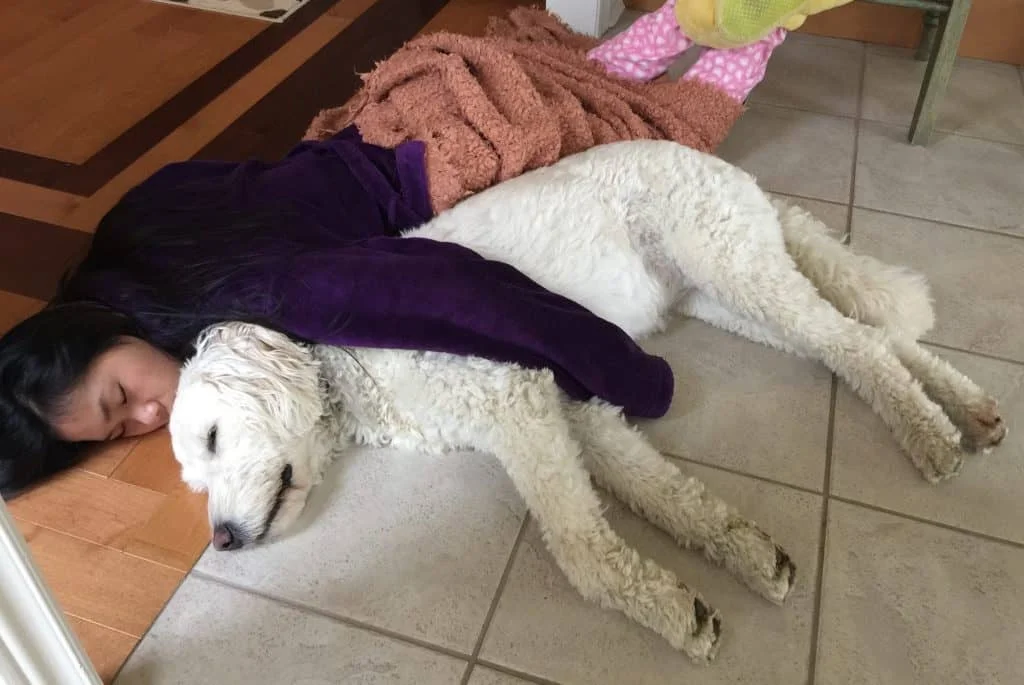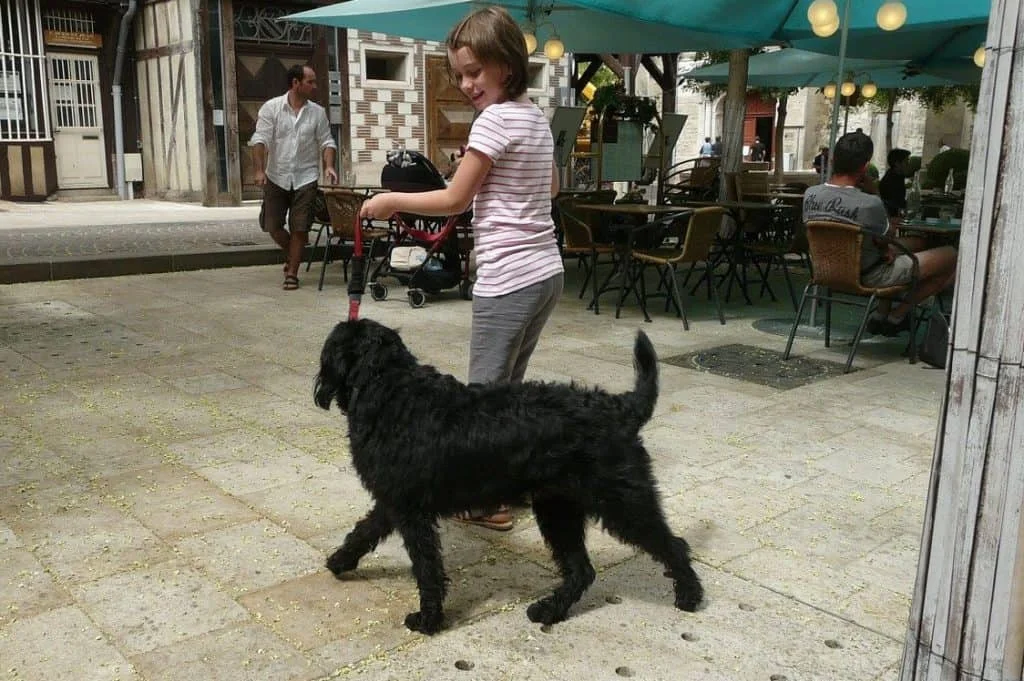Are Labradoodles Good with Kids?
Labradoodles are very good with kids. By nature, Labradoodles take to families and children rather quickly. Like poodles, they can be gentle and energetic. On the flip side, they also carry some genetic traits of their other parent, namely the Labrador retriever. This is what you need to be cautious about. Let’s take a look.
Labradoodles tend to be a really playful dog. In a fit of playfulness, the labradoodle might knock over your child. Worse still, the canine might not take kindly to whiskers/tail being pulled and might react.
This is precisely the situation you need to condition yourself, your family, and the Labradoodle for. To prepare for this you need to start conditioning your Doodle as a puppy
Building the Labradoodle-Kids Rapport
First month:
• This is the most challenging, even though Labradoodles are a family-oriented breed;
• The best way to tackle the situation is for the adult caregiver to take charge of the Doodle and the kids, especially while interacting;
• Constant supervision is needed as far as the routine of the canine is concerned;
Second month:
• By this time you will have determined the labradoodle’s routine in terms of napping, eating, playing and rituals;
• Prepare a written time-table and hang it somewhere everyone, including the kids, can see/consult it;
• Active supervision is essential during this phase too, regardless of the time of day or the activity;
• Make playtime interesting through a variety of games involving the Doodle and the kids;
On-going basis:
• Set aside a time of day for training the Doodle and the kids. Routine is important;
• Regular and proactive training schedules ensure that the kids and the labradoodle not only get along but also enjoy each other’s company;

Labradoodle-Kids Interaction Dos’ & Don’ts
Dos –
• Preferably keep the labradoodle with you for most of the day, well, except while sleeping/eating;
• In addition to play-time, set aside some time for cuddling, showering affection and pampering the Doodle as a family;
• Encourage quiet and entertaining playtime games wherein much of the interaction is supported through mutual understanding;
• Establish a clear hierarchy from the outset, putting yourself as the leader whom the kids, as well as the labradoodle, must follow;
• Train the labradoodle to trade a non-playing object for a toy, in case the Doodle displays a penchant for picking up things around the house to draw attention;
• Play some sort of fetch game with the labradoodle to encourage exercise and as a way of positive interaction. Our Doodle loves to tug on a rope in the backyard;
• Important- Early and proper socializing goes a long way in determining the labradoodle’s behavior not just with the family but also with visitors;
• Protect the labradoodle from strangers to foster a sense of security;
• As far as possible, conform to the labradoodle’s individuality and plan activities accordingly to receive a positive response;
Don’ts –
• Till the children and the labradoodle are used to each other, do not leave them unsupervised;
• Do not allow children to carry the labradoodle, especially when both are new to each other, and even later allow this only under supervision;
• During playtime, avoid screaming and meaningless running around, as it might cause the labradoodle to get too excited and the situation might spiral out of control;
• Kids must not interfere or mess around with the Doodle’s eating and sleeping space, as these are regarded as being sanctimonious;
• Never leave the labradoodle out on its own, unless the yard is fenced and secure from outside animals;
• When you take the labradoodle out for its ritual, either leave the kids indoor or instruct them to stand quietly, as pets seldom relieve themselves with children running around;
• Avoid leaving things on the floor as these would invariably get picked up by the Doodle and either chewed away or stashed somewhere;
• Because Labradoodles are family dogs, they should never be left outside on their own, even during playtime;

Do You Need A Trainer For Your Labradoodle?
If the children in the family are under 5 years of age, appointing a trainer helps. Likewise, for a family wherein everyone goes out daily leaving the Doodle alone at home, training plays a crucial role in preventing behavioral issues. That being said, what matters most is the quality of training. To this effect, you might be tempted to train the labradoodle on your own. However, for best results, entrust this task to a reputed and reliable trainer and enjoy the results.
Reasons why you should hire a trainer –
• Like humans, Doodles vary in their interaction with children which you might take time to understand;
• Your personal approach towards building a rapport between the kids and the Doodle may not always work;
• A professional trainer can foster understanding between the family and the Doodle;
When carried out for a prolonged duration, like one year or longer, professional training does have a positive bearing on the labradoodle-family relationship. In the event you disagree with the trainer, go for a change and try out a professional whom you find more convincing. But do not give up on the idea altogether. Training does play an important role in shaping up your labradoodle into liking kids and interacting with them.
Preparing Your Family for the Labradoodle
Bringing home a labradoodle is like adding a kid to the family. Needless to point out, the situation at home is very much the same as when the family greets any new arrival. Like kids, the Doodle typically starts by testing how firm you are with the rules. Initially, Labradoodles take every opportunity to test your patience by pushing boundaries. So the onus is on you to wield the iron hand clothed in a velvet glove as a way of maintaining all-round discipline.
Guidelines to prepare yourself and your kids for the Labradoodle –
Conducting a Lifestyle Check
It is common for several dog breeds to reflect and adopt the lifestyle of their owners. This explains why Doodles in a sedentary family tend to put on weight rather quickly, and ones in an undisciplined household take pride in running amok and flouting rules.
Chances of your labradoodle and your kids of getting along will rise if your household reflects discipline. The Doodle that watches family members follow rules will automatically settle into the same groove.
Ensuring Uniform Rules
Whether it is the Doodle or the kids, one golden rule that should apply to everyone entails listening to you. Not only should the children willingly follow your directions, but the labradoodle should also realize that listening to you is the norm.
Also, ensure that the rules for the kids and the Doodle are uniform so that both parties feel equally privileged.
Setting Aside Time
For your labradoodle to get along with kids, spend some time with it every day. Utilize this time for training, love, rituals, games, or simply an outdoor romp. Given the reassurance of adequate safety and security, the Doodle is sure to endear to kids and share healthy and positive relations with them.
Continuing with Training
Regardless of the trainer working on your labradoodle, you must continue with training well into adulthood. Continued training ensures a well-behaved Doodle, while a break could lead to surfacing of unpleasant behavior which might be difficult to control.
How to Choose a Labradoodle for Your Kids
The concept of selection arises from the fact that not all Labradoodles are born equal. Some might be inherently compliant while others might be just as rebellious or hyperactive.
Some traits that you must look out for pertaining to –
• Temperament, wherein a higher drive implies plenty of jumping around and crazy movement
• Parentage, in terms of checking out the parents of the labradoodle and their medical history
• Social skills, as these determine whether the Doodle would regard children as being good/threat
• Generation, as to whether the labradoodle is first/second/third generation since this has a profound bearing on the behavior
• Reputation and reliability of the breeder
Summing Up
Much of the outcome of the equation – Labradoodles + Kids – depends on how you handle the situation. Start by introducing the two parties and teach them how to respect and communicate with each other. Going ahead, establish some ground rules that foster mutual respect between the Doodle and the kids, but make it a point to be gentle with both.
As long as you are consistent and firm with the rules of interaction, the outcome of the equation – Labradoodles + Kids – is always love and friendship.
Do not expect your Doodle to tolerate bad behavior and refrain from entrusting your child with the responsibility that they may not be ready for. Labradoodles cannot talk, but they are sure to show their appreciation and love in myriad ways if they are embraced and looked after well.
